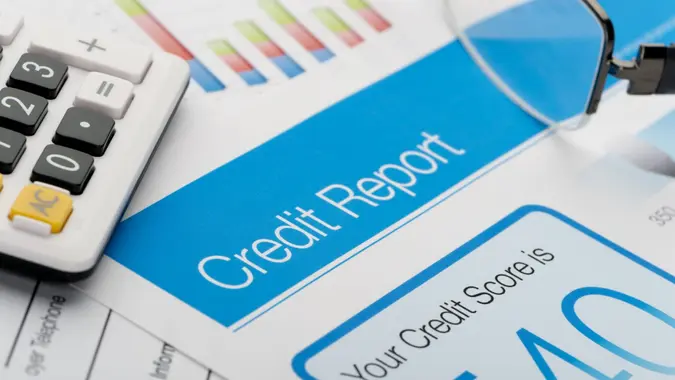How To Get 800 Credit Score: It’s Faster Than You Think

Commitment to Our Readers
GOBankingRates' editorial team is committed to bringing you unbiased reviews and information. We use data-driven methodologies to evaluate financial products and services - our reviews and ratings are not influenced by advertisers. You can read more about our editorial guidelines and our products and services review methodology.

20 Years
Helping You Live Richer

Reviewed
by Experts

Trusted by
Millions of Readers
You can have many years of good credit under your belt without reaching the coveted 800 club. Make no mistake, it is possible to achieve an 800 credit score with the right strategy. It takes time, consistency and good financial habits — but it’s easier than you may think.
How To Get 800 Credit Score: Step-by-Step Guide
Here’s how to get 800 credit score in five straightforward steps.
Step 1: Pay Bills on Time
Your payment history accounts for 35% of your credit score. Paying your bills late will result in a decrease in your overall score. Consider signing up for automatic payments to ensure everything is paid on time.
Good To Know
If you accidentally miss a payment, call your lender immediately and ask if they can waive the late fee or avoid reporting it to credit bureaus.
Step 2: Keep Your Credit Utilization Low
Credit utilization is 30% of your credit score. It’s calculated by taking your debt and dividing it by your total available credit. Typically you’ll want to have a credit utilization rate of 30% or less.
If you have a credit card with a limit of $1,000 and you currently owe $300, you’re at that limit. Obtaining more debt could negatively impact your credit score. Instead, consider the following:
- Request a credit limit increase.
- Pay off your balance before the statement closes to keep reported balances low.
Step 3: Build a Long Credit History
Lenders typically view borrowers with short credit histories as riskier. To reach an 800 credit score, you’ll need to establish and maintain a long history. You should keep those old accounts open — even if you don’t use them anymore and have no balance — instead of having them removed from your credit report.
Step 4: Use Different Types of Credit
You can strengthen your credit by diversifying your accounts. This doesn’t mean you should open 10 different credit card accounts; what it means is that you should have different types of credit.
Here are a few to consider:
- Mortgage
- Financed auto loan
- Student loan
- Credit cards
Step 5: Check Your Credit Reports for Errors
Mistakes on your credit report can lower your score, even if you’re managing credit well. Check your reports often to catch errors.
Once a year, you can request a free annual credit report from the country’s top three credit reporting companies. If you find any issues on your Experian, Equifax or TransUnion free credit report, you should take action immediately to correct your credit reports.
Benefits of an 800 Credit Score
A credit score of 800 or higher is considered excellent under most scoring models. Since credit scores range from 300 to 850, an 800 score means you’re just shy of perfect.
There are a few benefits that come with a high credit score:
- Easier loan or credit card approvals.
- Lower interest rates on mortgages and auto loans.
- Higher credit limits since lenders will trust you.
How Long Does It Take to Get an 800 Credit Score?
The time it takes to reach 800 depends on where you’re starting from:
- If you already have good credit, you might be able to reach 800 within 1-2 years by consistently following the steps above.
- If you are starting from scratch or recovering from bad credit, it can take a few years to reach 800.
Quick Wins: What You Can Do Today
If you’re aiming for an 800 credit score, a few simple actions can move the needle quickly. Start by setting up autopay to avoid missed payments, which are one of the biggest credit score killers. Next, try to pay down your credit cards before your statement closing date — this can reduce your reported credit utilization, which makes up 30% of your FICO score.
You can also request a credit limit increase (without taking on new debt) to lower your utilization ratio. If you’re new to credit, consider becoming an authorized user on a responsible family member’s credit card to build history.
Lastly, review your credit reports for errors or outdated information and dispute anything that’s inaccurate.
Keep Your Score High–Even After You Hit 800
Reaching an 800 score is impressive, but staying there takes ongoing effort. Always pay your bills on time, even for small balances, and keep your credit utilization low, ideally under 10%. Avoid closing old accounts unless absolutely necessary, since length of credit history is a key factor.
Lastly, monitor your credit reports regularly to catch any signs of fraud or reporting errors before they hurt your score. Good credit is a long game–protect it like an asset.
FAQ
Here are the answers to some of the most frequently asked questions about credit scores.- How hard is it to get an 800 credit score?
- It takes consistent good habits but it is achievable with on-time payments, low credit utilization and a long credit history.
- Do you need a perfect credit history to get 800?
- No, you can make a few minor mistakes and still reach a score of 800.
- Can I get an 800 credit score if I’ve had late payments in the past?
- Yes, as time passes, older negative marks have less impact.
- Does having an 800 credit score actually save money?
- With a score of 800, you can qualify for lower interest rates which can save thousands on mortgages, car loans and credit cards.
Our in-house research team and on-site financial experts work together to create content that’s accurate, impartial, and up to date. We fact-check every single statistic, quote and fact using trusted primary resources to make sure the information we provide is correct. You can learn more about GOBankingRates’ processes and standards in our editorial policy.
- Experian. "What Is a Good Credit Score?"
- CreditStrong. "How to Get Your Credit Score From 750 to 800."
 Written by
Written by  Edited by
Edited by 






















